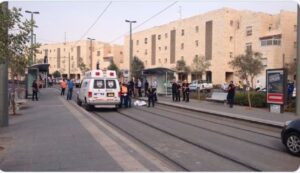- 1.4K
- 1.4KSHARES
A Los Angeles Times review of a documentary film covered up a 2015 terror attack in which a 13-year-old Israeli boy was nearly killed and a second Israeli civilian was also seriously injured, referring to a Palestinian teen “who chased people with a large, ornamental knife with the intention of scaring them.” The piece does not at all mention that two Israelis were severely injured in the Oct. 12, 2015 Jerusalem attack carried out by two Palestinian cousins, Ahmad (also spelled Ahmed) and Hassan Manasrah.
In a glowing review of “Advocate,” a documentary about Israeli lawyer Lea Tsemel who defends Palestinian terrorists, Kenneth Turan wrote (“Review: ‘Advocate’ Reveals A Rebel With a Lost Cause,” in print Jan. 3, “Winning portrait of a losing lawyer. . . “, page E1):
The most heart-rending case, and the one we follow from start to finish, is the story of Ahmad, a 13-year-old who chased people with a large, ornamental knife with the intention of scaring them but ended up being charged with attempted murder.
Among the quandaries Tsemel has to deal with is whether to plead Ahmad guilty to the attempted murder charge she knows is a fiction before the boy turns 14, in an attempt to get him a lighter sentence.
Nowhere does the description of the event even mention that 13-year-old Naor Shalev Ben-Ezra and 25-year-old Yosef Haim Tuito were gravely injured, despite the fact that the documentary itself does note that two civilians were injured in the incident.
Moreover, regarding the “decorative knife,” it would have been helpful for readers to know that its blade measured 15 centimeters long, and was therefore quite capable of serious harm. As a High Court ruling on the case found [translation from Hebrew by CAMERA]:
The two discussed their desire to become “martyrs” and be killed in war for the cause of religion, by carrying out a stabbing attack against Jews in order to kill them. The appellant [Ahmad Manasrah] and H. [Hassan] each went into their homes and took knifes. The appellant took a decorative knife with a 15-centimeter blade, and H. took a big kitchen knife with a 20-centimeter blade.
Indeed, the court’s finding later notes (page 22) that “The defendant and his cousin sought to die together as martyrs [Arabic: Shaheed] and to carry out ‘jihad.’ To that end, the appellant equipped himself with a large knife intended, as he put it, to ‘slaughter sheep’ or as a ‘solution to the conflicts.'”
The High Court justices go on to describe how Hassan stabbed Ben-Ezra and then the two Manasras fled together, chased by two bystanders who witnessed the attack. According to the justices:
Bypassers who saw what happened hurried to help the boy [Ben-Ezra] and the two began to flee up an ascent on HaShisha-‘Asar Street. Some of the bystanders, including Shimon Mizrachi and Yehuda Chernokov (herein Shimon and Yehuda, respectively) ran after them. Close to the intersection of HaShisha-‘Asar Street and Moshe Dayan Boulevard, Shimon ran after H. and the appellant, who was running on the left side of the street, ran after Shimon with a knife in his hand. Yehuda yelled towards Shimon to be careful of the appellant. Shimon turned towards the defendant and attempted to neutralize him with a broomstick that he held in his hand, but the defendant dodged him and continued running on Moshe Dayan Boulevard in the direction of the city center, against the flow of traffic, until he was hit by a car.
About the attack on Tuito, Israel’s High Court determined that Ahmad’s felony was attempted murder and that his guilt was proven beyond all reasonable doubt. The justices wrote:
We adjudicate that the mens rea for the offense of attempted murder was crystallized, and that the appellant is guilty of this offense as a joint accomplice is proven beyond all reasonable doubt. This determination is based on the indisputable fact that the appellant raised his knife against the plaintiff [Tuito]; from the testimonies and evidence it was apparent that the appellant continued to chase after the plaintiff with a knife drawn after he was wounded, as it is also possible to see in the clip from the security camera from the nearby convenience store (the 5th clip […]); from various circumstantial evidence and the shape and characteristics of the knife that the appellant held in his hand and from the way that the plaintiff was stabbed. Moreover, there are also the testimonies of eye-witnesses that were found to be reliable and are all consistent with each other.
CAMERA has contacted The Times to request an editor’s note making clear that in the attack in which Ahmad took part, two Israeli civilians, including a 13-year-old boy, suffered serious stab wounds. In addition, the “decorative knife” that Ahmad used had a 15 centimeter blade, and Ahmad himself said it was intended to “slaughter sheep” and regarded it a “solution to conflicts.” Stay tuned for an update.
With research by Shlomi Ben-Meir
This post was updated on Jan. 8 to add that the documentary “Advocate” reports that civilians were injured in the attack.

